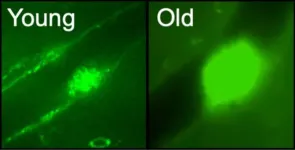(Press-News.org) As people age, they become more prone to blood clotting diseases, when blood cells called platelets clump together when they don’t need to and can cause major issues such as strokes and cardiovascular disease. For decades, scientists have studied why older people’s blood cells behave in this way, using their insights to develop the myriad of blood-thinning drugs now on the market for treating the leading cause of death in the United States.
Now, UC Santa Cruz Professor of Biomolecular Engineering Camilla Forsberg and her research group have discovered a distinct, secondary population of platelets that appears with aging and have hyperreactive behavior and unique molecular properties, which could make them easier to target with medication. The researchers traced this population of platelets to its stem cell origins, finding what they identify as the first-ever-discovered age-specific development pathway from a stem cell to a distinct mature platelet cell.
“The question for decades and decades has been: why are aging people at such high risk for excessive blood clotting, stroke, and cardiovascular disease?” Forsberg said. “We have this discovery of a whole new pathway that progressively appears with aging — troublemakers! That was never part of the discussion.”
The research group presented their findings in a paper published in the prestigious journal Cell. First author Donna Poscablo, Forsberg’s former Ph.D. student who is now a postdoctoral scholar at Stanford University, and her peers carried out these experiments with the resources and training environment at the Institute for the Biology of Stem Cells (IBSC) at UC Santa Cruz.
Understanding platelets
Platelet cells are one of three types of blood cells produced by the body, with red and white blood cells being the other two. Millions of these cells float around in the blood at all times, and when an injury occurs either internally or externally, they clot together to form a natural, living bandaid. Platelet dysregulation, which is known to increase with age, occurs when these cells are either hyperreactive and form clots too often, or are underperforming. In both cases the body can’t properly manage bleeding and clotting, although hyperreactivity is a much more widely-seen problem.
All blood cells begin as hematopoietic stem cells, a special class of stem cells, and then mature through a series of intermediary steps called a “differentiation pathway” that lead them to their fate as either platelets, red blood cells, or white blood cells. It’s been known for decades that these hematopoietic stem cells decline with age, but that presents a contradiction for scientists: if the hematopoietic cells are less healthy, then why are the platelets they create hyperreactive?
A ‘shortcut’ pathway
As stem cell biologists, the researchers at UC Santa Cruz approached this question by investigating the hematopoietic stem cells.
They conducted experiments that allowed them to trace the lineages of these stem cells in mouse models, and discovered that in aged mice some of their platelets did not travel along the differentiation pathway. Instead, they took what the UCSC researchers dubbed a “shortcut” pathway, skipping over the intermediary steps and immediately becoming megakaryocyte progenitors, the blood cell stage immediately before platelet production. To the researchers’ knowledge, this is the first age-specific stem cell pathway ever discovered.
“People think of [platelets and red blood cells] as one lineage that shares regulation and intermediate stages until the very end,” Forsberg said. “To see that [the secondary platelet population] were completely separated all the way from the stem cell level, only in aged mice, was really surprising.”
While the population of platelets produced from the shortcut pathway are hyperreactive, the platelets produced from the main pathway continue to behave like the platelets in a young person.
“The gradual differentiation cascade maintains a youthful property, and I feel like that is also surprising within itself,” Poscablo said.
They found that the hyperreactive secondary platelets start to be produced around midlife for the mice, with their population growing progressively with aging. As of now, the researchers have not found a trigger that begins the production of this secondary pathway. Unexpectedly, however, it does not seem to be triggered by the aging environment itself: when a young hematopoietic stem cell is transferred into an aged environment, it doesn't seem to trigger the shortcut pathway; and when an aged hematopoietic stem cell is put into young environment, the old stem cells continue to operate as old stem cells.
“That was surprising, the age resilience of the other pathway,” Forsberg said. “One of the platelet populations is not affected at all [by aging], whereas the one we have discovered is — so the whole phenomenon is not primarily induced by the environment, but by the differentiation path.”
Choosing better treatments
Knowing that this secondary population of platelets exists will help researchers find new ways to target and regulate these problematic cells via their stem cells. Before this, researchers have not tried to target these upstream cells.
“From our expertise, we can ask the questions of how to target the hematopoietic stem cell and now the megakaryocyte progenitor, which has never really been highlighted before as a place to target,” Poscablo said.
Targeting these cells may not require the creation of new medications, but more simply inform the prescription of existing blood thinners such as Aspirin, which treat different patients to varying degrees even if they present with similar clotting-related symptoms. Using their mouse models, the researchers will identify which of the two populations of stem cells are more sensitive to Aspirin and the myriad of other platelet drugs on the market.
The UCSC researchers are also currently working on finding this secondary population of platelets in human cells with the support of a grant from the California Institute for Regenerative Medicine (CIRM). In the mouse models, they will continue to study how to manipulate and control the shortcut pathway, with funding from the National Institutes of Health (NIH) .
Collaborators on this research included UCSC Assistant Professor of Applied Mathematics Vanessa Jönsson and University of Michigan Medical School’s Reheman Adili and Michael Holinstat. Current and former IBSC scholars on this project included Atesh Worthington (now at UC San Francisco), Stephanie Smith-Berdan, Marcel Rommel, Bryce Manso, Lydia Mok, Roman Reggiardo, Taylor Cool, Raana Mogharrab, Jenna Myers, Steven Dahmen, Paloma Medina, Anna Beaudin (now at the University of Utah, Salt Lake City), and Scott Boyer.
END
Distinct population of ‘troublemaker’ platelet cells appear with aging, lead to blood clotting, disease
Targeting this population of platelets could help better treat blood clotting-related diseases
2024-05-14
ELSE PRESS RELEASES FROM THIS DATE:
2023 was the hottest summer in two thousand years
2024-05-14
Researchers have found that 2023 was the hottest summer in the Northern Hemisphere in the past two thousand years, almost four degrees warmer than the coldest summer during the same period.
Although 2023 has been reported as the hottest year on record, the instrumental evidence only reaches back as far as 1850 at best, and most records are limited to certain regions.
Now, by using past climate information from annually resolved tree rings over two millennia, scientists from the University of Cambridge and the Johannes Gutenberg University Mainz have shown how exceptional the summer of 2023 was.
Even allowing for natural climate variations over hundreds of years, 2023 was still ...
Analysis of previously unstudied areas of the human genome suggests people with more copies of ribosomal DNA have higher risks of developing disease
2024-05-14
UNDER STRICT EMBARGO UNTIL 4PM GMT (11AM ET) on 14 May 2024.
Peer reviewed | Observational | People
Ribosomal DNA (rDNA) is present in hundreds of copies in the genome, but has not previously been part of genetic analyses. A new study of 500,000 individuals indicates that people who have more copies of rDNA are more likely to develop inflammation and diseases during their lifetimes.
Standard genetic analysis techniques have not studied areas of the human genome that are repetitive, such as ribosomal ...
Study reveals mixed public opinion on polygenic embryo screening for IVF
2024-05-14
Three out of four U.S. adults support the use of emerging technologies that estimate a future child’s likelihood of developing health conditions influenced by multiple genes — such as diabetes, heart disease, and depression — before an embryo is implanted during in vitro fertilization (IVF), according to a new public opinion survey led by researchers at Harvard Medical School.
Results of the survey, to be published May 14 in JAMA Network Open, underscore the need for public education and conversation about the positive ...
Congenital anomalies are ten times more frequent in children with neurodevelopmental disorders
2024-05-14
Children with neurodevelopmental disorders report congenital abnormalities, such as defects of the heart and/or urinary tract, at least ten times more frequent compared to other children. This is one of the findings from an analysis from Radboud university medical center of data from over 50,000 children. Thanks to this new database, it's now much clearer which health problems are associated with a particular neurodevelopmental disorder and which are not. The study has been published in Nature Medicine.
Two to three percent of the population have a neurodevelopmental disorder, such as autism or intellectual ...
Does pharmacological treatment of ADHD reduce criminality?
2024-05-14
May 14 2024 – A study in the Journal of the American Academy of Child and Adolescent Psychiatry (JAACAP), published by Elsevier, found that pharmacological treatment of attention-deficit/hyperactivity disorder (ADHD) reduced violence- and public-order related crimes. However, it did not reduce other types of crimes, among patients with ADHD in early to late adolescence considered to be in the grey zone (or on the margin) for such treatment.
This study uses variation in healthcare providers treatment preference as the basis for a quasi-experimental design that examines the effect of pharmacological ...
WCM awarded grant to study RNA processing in prostate cancer
2024-05-14
A team led by Dr. Eddie Imada, assistant professor of research in pathology and laboratory medicine, has been awarded a three-year, $1.5 million United States Department of Defense grant for research on a cellular process called alternative polyadenylation and its role in prostate cancer.
The grant was awarded under DoD’s long-running Prostate Cancer Research Program, a Congressionally-directed medical research funding project aimed at improving prostate cancer prevention, detection and patient care. Thousands of current and former servicemen ...
Artificial intelligence tool to improve heart failure care
2024-05-14
UVA Health researchers have developed a powerful new risk assessment tool for predicting outcomes in heart failure patients. The researchers have made the tool publicly available for free to clinicians.
The new tool improves on existing risk assessment tools for heart failure by harnessing the power of machine learning (ML) and artificial intelligence (AI) to determine patient-specific risks of developing unfavorable outcomes with heart failure.
“Heart failure is a progressive condition that affects not only quality of life but quantity as well. All heart failure patients are not the same. Each patient ...
People without an inner voice have poorer verbal memory
2024-05-14
Previously, it was commonly assumed that having an inner voice had to be a human universal. But in recent years, researchers have become aware that not all people share this experience.
According to postdoc and linguist Johanne Nedergård from the University of Copenhagen, people describe the condition of living without an inner voice as time-consuming and difficult because they must spend time and effort translating their thoughts into words:
“Some say that they think in pictures and then translate the pictures into words when they need to say ...
Courtship through flute song in Indigenous Southern Plains culture #ASA186
2024-05-14
OTTAWA, Ontario, May 14, 2024 – Every love story is unique, and in traditional Indigenous Southern Plains culture, it begins with an original ballad performed on the flute. In order to win a lover’s affection, and respect among the tribe, each pursuer must compose one good flute serenade.
Paula Conlon, a former music professor at the University of Oklahoma, has researched the history and cultural significance of the Indigenous flute since the 1980s. Conlon will present her work Tuesday, May 14, at 9:45 a.m. EDT as part of a joint meeting of the Acoustical Society of America and the Canadian Acoustical ...
SwRI investigating unusual substorm in Earth’s magnetotail using MMS data
2024-05-14
SAN ANTONIO — May 14, 2024 —Southwest Research Institute is investigating an unusual event in the Earth’s magnetotail, the elongated portion of the planet’s magnetosphere trailing away from the Sun. Using data from NASA’s Magnetospheric Multiscale (MMS) mission, SwRI scientists are examining the nature of substorms, fleeting disturbances in the magnetotail that release energy and often cause aurorae.
Since their launch in 2015, the MMS spacecraft have been surveying the magnetopause, the boundary between the magnetosphere ...
LAST 30 PRESS RELEASES:
New expert guidance urges caution before surgery for patients with treatment-resistant constipation
Solar hydrogen can now be produced efficiently without the scarce metal platinum
Sleeping in on weekends may help boost teens’ mental health
Study: Teens use cellphones for an hour a day at school
After more than two years of war, Palestinian children are hungry, denied education and “like the living dead”
The untold story of life with Prader-Willi syndrome - according to the siblings who live it
How the parasite that ‘gave up sex’ found more hosts – and why its victory won’t last
When is it time to jump? The boiling frog problem of AI use in physics education
Twitter data reveals partisan divide in understanding why pollen season's getting worse
AI is quick but risky for updating old software
Revolutionizing biosecurity: new multi-omics framework to transform invasive species management
From ancient herb to modern medicine: new review unveils the multi-targeted healing potential of Borago officinalis
Building a global scientific community: Biological Diversity Journal announces dual recruitment of Editorial Board and Youth Editorial Board members
Microbes that break down antibiotics help protect ecosystems under drug pollution
Smart biochar that remembers pollutants offers a new way to clean water and recycle biomass
Rice genes matter more than domestication in shaping plant microbiomes
Ticking time bomb: Some farmers report as many as 70 tick encounters over a 6-month period
Turning garden and crop waste into plastics
Scientists discover ‘platypus galaxies’ in the early universe
Seeing thyroid cancer in a new light: when AI meets label-free imaging in the operating room
Neutrophil-to-lymphocyte ratio may aid risk stratification in depressive disorder
2026 Seismological Society of America Annual Meeting
AI-powered ECG analysis offers promising path for early detection of chronic obstructive pulmonary disease, says Mount Sinai researchers
GIMM uncovers flaws in lab-grown heart cells and paves the way for improved treatments
Cracking the evolutionary code of sleep
Medications could help the aging brain cope with surgery, memory impairment
Back pain linked to worse sleep years later in men over 65, according to study
CDC urges ‘shared decision-making’ on some childhood vaccines; many unclear about what that means
New research finds that an ‘equal treatment’ approach to economic opportunity advertising can backfire
Researchers create shape-shifting, self-navigating microparticles
[Press-News.org] Distinct population of ‘troublemaker’ platelet cells appear with aging, lead to blood clotting, diseaseTargeting this population of platelets could help better treat blood clotting-related diseases






